Pinarello: history of the brand with the most Tour de France victories
It's one of those epic names that, when spoken, sounds of sophistication, history and precision. And, given that it has turned 70 years old in 2022, it is the perfect time to look back and tell the history of Pinarello: the bicycle brand with the most victories in the Tour de France. A tale of winners and leaders that, ironically, begins with a rider who 'conquered' the 'maglia nera' of the Giro.
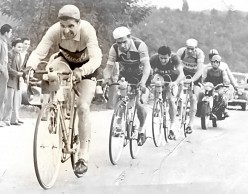
The humble beginnings of Pinarello's history
Every country has its own type of bicycle brand founder: in France they were big industrialists, sometimes dedicated to automobiles; in Spain, armory factories; in the United States, visionary entrepreneurs in a garage; in Italy, however, they were humble cyclists who took advantage of the money from competitions to open a workshop. Giovanni Pinarello, whom everyone affectionately called Nani, fit the archetype perfectly.
Born in 1922 near the city of Treviso, in Veneto, at the age of 15 he joined the Paglianti factory, a company that made motorcycles and bikes with motors (which, by the way, can still be found on the internet). Giovanni fell in love with cycling and, after the war, he became a professional, sharing time with Coppi, Bartali, Fiorenzo Magni... The real golden era of the country, when the Italian army crossed the Alps year after year to win the Tour de France. Something that would remain in Nani's mind forever.
RECOMENDADO

The best apps for cycling and mountain biking

Black Friday 2025 cycling bargains: save on Garmin, POC, Maxxis and more

Black Friday Garmin 2025: the ultimate guide to choosing your GPS at the best price

Which profile wheels to choose according to the area where you live: mountain, flat or coast

How to wash your cycling clothes? 10 keys to make them always look new

Cycling can help you fight the effects of the time switch
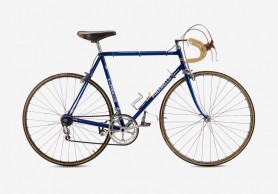
Certainly he didn't reach those levels. He was a good support rider, and even achieved some minor triumphs, but what he is most remembered for as a rider is for having been the last 'maglia nera' of that first era. Because the 40s and 50s were not only the time of epic winners; they were also the time of legendary losers.
That black jersey, which Torriani and company invented to distinguish the last rider in the general classification, provoked great rivalries such as that of Sante Carollo and Luigi Malabrocca, whose stories are still told today for their peculiar mixture of cycling and picaresque. In 1951, Nani Pinarello took that questionable lead, which came to have greater prizes than those given to the 6th overall, because it became a favorite of the fans and sponsors.
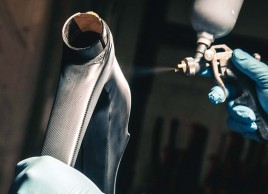
However, after protests from the riders, who considered that it resulted in spectacles far from the spirit of the sport, the 'maglia nera' was suppressed for the following year (it only resurfaced one year in the 60s). And Nani's team, Bottecchia, decided to get rid of him without any prior notice.
To compensate him, they paid him 100,000 lire, which, adjusted for inflation, would be about 2,000 euros today, but in post-war Italy it was a small fortune. Making a virtue out of necessity, the thirty-something Pinarello decided to do what many cyclists did: open a bicycle workshop in his village. But in addition to fixing bikes, he had a bigger dream: to be a builder. And, thanks to what he had learned at Paglianti, he set to work in 1952, the same year in which also opened what would become his great rival, Ernesto Colnago.
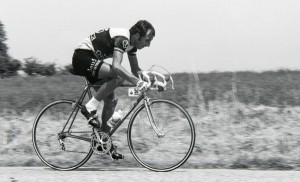
The first victories in Pinarello's history
So Nani Pinarello began to offer his bikes to small local teams in Treviso, who tested them and helped him to perfect them. Of course, success did not come overnight, and it was almost a decade before his brand (baptized with his sonorous surname, reminiscent a little of Pininfarina and a little of the Pinerolo where Coppi won alone) had its first big moment on the international scene. It was in 1961, when the Treviso-born Guido De Rosso won the first edition of the Tour du Porvenir, which at the time was for amateurs.
It took another decade before they made the leap to the professional teams, with the modest Jollj Ceramica in 1972. And three years later, in 1975, everything accelerated: the unknown Fausto Bertoglio, who was not even the leader of that team, surprisingly won a Giro d'Italia that ended at the top of the Stelvio, and that almost went to the Spanish Francisco Galdós.
He took a 'young' Pinarello to the top of the podium for the first time, ahead of the then all-powerful Bianchi and the Colnago ridden by Eddy Merckx and the KAS team. This was to be repeated in 1981 with a fellow Veneto rider, Giovanni Battaglin, in La Vuelta a España. And, three days after finishing it, Battaglin himself showed up at the start of the Giro d'Italia to race it as well. But not only that: after 45 days of almost uninterrupted competition, the man was about to wear the maglia rosa. And Pinarello was largely responsible for his success.

Why? Because that stage ended at Tre Cime di Lavaredo, with its terrible last 3 km, averaging over 11%. And, specifically for that stage, Pinarello came up with a brilliant idea: its technician Elvio Borghetto took one of the Campagnolo dual crankset systems (53/44) they used and fitted it with a third 36-tooth chainring, taking care to do it with such precision that Battaglin did not have to change his pedaling position. A triple chainring that was then a rarity and that gave him a very advantageous development on hard ramps.
The difference can be seen in the videos of the stage on YouTube: while the escapees and other favorites, such as Giuseppe Saronni or Roberto Visentini, were stuck on that infernal road, the rider on the Pinarello bike attacked with a fairly high cadence (for the time) and distanced them with astonishing ease. Three days later, Battaglin completed the Vuelta-Giro double, a feat that only two other people have ever achieved: Eddy Merckx and Alberto Contador. And the brand took advantage of those triumphs to promote itself to the general public. So in 1982, it launched a model called Tre Cime, which reproduced the champion's bike... but without the triple crankset, of course.
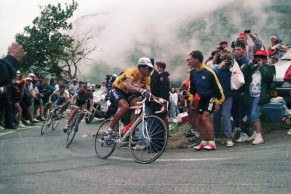
Pinarello's future was in Spain
However, a couple of years earlier the most important meeting in Pinarello's history had taken place, although at the time perhaps no one was aware of it. It was in 1979, when José Miguel Echávarri, who was starting up the Reynolds team, visited the factory of Tullio Campagnolo (another Venetian) in Italy. He introduced him to Nani, and the Navarrese returned convinced that his team should use those bikes and components.
He couldn't do it during the first years, but as soon as he had his hands free, in 1982, he formed an alliance with them that would last three decades almost uninterrupted. With them would come the first of his 15 Tours to date, in the legs of Perico Delgado. Shortly after, however, Nani Pinarello handed over the company to his son Fausto (whose name, of course, comes from his father's idol, Coppi). And the now Banesto team decided to leave the Italians for a French aerospace brand that had become very popular in those years: TVT.
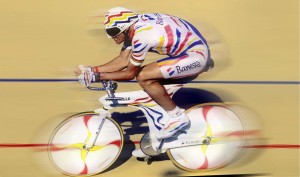
It was 1991, and that mistake of letting the Spanish squad escape must still be fresh in Pinarello's mind. Because that year Miguel Induráin won his first Tour de France. Fausto learned quickly, however, and the following year the agreement with Echávarri and company returned, with a sponsorship included. And they had no regrets: the following 2 Giros and 4 Tours were won by Miguelón with their bikes.
But if any item is still remembered today from that time, if anything became an icon throughout Spain, and in the world of cycling around the globe, it is the Sword. The aerodynamic carbon bike with which Induráin achieved that mediatic Hour Record in 1994, perhaps the most famous in history, marked an important milestone for Pinarello. To create it, they brought in none other than one of the engineers of the Lamborghini Formula 1 team: Marco Giachi. Hence the name of the model, the same as that of a well-known car from the 1970s.
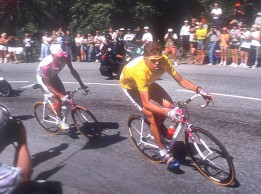
Pinarello from post-Induráin to Sky/Ineos
Such was the aura that, thanks to all that, surrounded Pinarello, that the next two Tour de France winners also rode his bikes: Bjarne Rijs and Jan Ullrich did not dare to leave the Navarrese's wake, not even in that. The streak was broken in 1998, when Marco Pantani rode a Bianchi to become the last aluminum bike to stand on the podium in Paris.
Then came the absolute domination of the American brands, led by Trek, in the dark 2000s. Although Pinarello still had its moment of glory in 2006, when Oscar Pereiro won the Tour ( although in court) with a magnesium model and Alejandro Valverde, the Liège-Bastogne-Liège; and in 2009, when the Spaniard won La Vuelta a España. But above all, 2003 saw the birth of the Pinarello Dogma, a name that is still alive today for its top-of-the-range models.
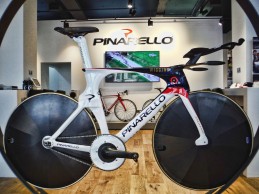
However, it is from 2010, with the entry on the scene of Team Sky ( now Ineos Grenadiers) that the brand returns to the top, with the Dogma and the Bolide time trial, which appeared in 2013. Its triumphs in this long decade are almost innumerable: 7 Tours de France with Wiggins, Froome, Thomas and Bernal (which brings its particular record to 15 victories), 2 Giros d'Italia, 2 Vuelta, Milano-Sanremo, Liège-Bastogne-Liège, World Championship, Olympic gold with Richard Carapaz, Hour record with Bradley Wiggins...
Together, these two companies have forever changed the face of cycling, with that philosophy of 'marginal gains' advocated by Dave Brailsford. Pinarello itself acknowledges: "Dogma is the fruit of our collaboration, the crowning achievement of 10 years of relentless research and absolute refinement".
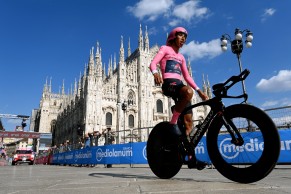
There's even an anecdote about this, which coincides with Mark Cavendish's presence on the British team in 2012. Apparently, Pinarello engineers brought the sprinter a production Dogma 2 frame to start working with him on possible changes and adjustments, as it had (and has) a reputation for being very demanding. The Isle of Man rider tested it and said, "No. This frame is perfect, don't even think about touching it!".
In addition, the last five years have seen two extremely important developments for a very traditional company that had specialized perhaps even too much in the road. First, 2017 saw its acquisition by the French luxury group LVMH (Louis Vuitton Moët Hennessy). Nothing strange here, because, within the world of cycling, few can argue that Pinarello is the closest thing to a luxury firm.

And, on the other hand, that same year they began to expand their catalog, with the appearance of their first eBike, the Nytro (today, they have up to 6 different models: one urban, two gravel, two road and one eMTB). Shortly after, in 2018, they presented the Grevil+, their own gravel bike. And, a few months ago, they unveiled the Crossista, their first cyclocross bike in 30 years, thanks to the influence of the great Tom Pidcock.
Given this progression, as well as the fact that the British rider has renewed by Ineos with a juicy contract, after several MTB brands were courting him, we can only hope that they already have some XCO novelty in the oven. At least for Pidcock to stop using another manufacturer's bike camouflaged in World Cup events. If so, we're anxious to see what it will be like. And if it will maintain the competitive DNA that has allowed this small Italian company to be the one that has achieved the most victories in the Tour de France.
And by far. After his 15 titles, we have to go down to Peugeot's 10. There is no color.